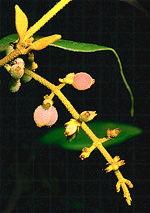 |
This small family is widely distributed both in the tropics and temperate regions of both hemispheres. In Australia it is restricted to the northern and eastern margin of the mainland, in rainforests, monsoon forests and woodlands.
Characteristic features of the family Viscaceae in Australia include:
- parasitic shrubs attached to branches of the host, some very small,
with cylindrical or flattened stems and opposite or no leaves
- flowers unisexual, often very small, in clusters at the joints of
stems or in axillary or terminal cymes
- perianth of 2–4 greenish or cream segments, free or fused
- ovary inferior, developing into a berry-like fruit with sticky flesh
Description
Evergreen aerial shrubs, partially parasitic on the stems of the host.
Leaves sometimes ±absent. Stem nodes conspicuously swollen or not;
internodes terete, oval, slightly or strongly flattened, or distinctly
angular. Internal secretions not obvious. Plants glabrous, or with simple,
dendritic, stellate, non-glandular, unicellular or uniseriate hairs, or
peltate scales. Leaves well developed or much reduced (i.e. to scales,
etc), opposite, petiolate, subsessile or sessile. Stipules absent. Lamina
simple, symmetric, filiform, acicular, subulate, linear, lanceolate, ovate,
elliptic, oblanceolate, obovate or oblong; base cuneate, attenuate or
rounded; margins entire, ±flat; venation pinnate, or parallel,
with the midrib conspicuous or inconspicuous, and the tertiary venation
reticulate or not reticulate; surfaces not punctate; herbaceous, leathery,
membranous or papery. Male and female flowers occurring on the same plant
or on separate plants. Inflorescences terminal or axillary, consisting
of capitula, racemes, dichasial cymes or solitary flowers. Bracts present
or absent. Pollination by insects. Flowers odourless, sessile or stalked.
Floral disc present. Perianth regular, of 1 whorl only, or vestigial,
with 2–4, free, sepaloid segments, or absent, cream or green, without
contrasting markings, herbaceous or papery, sometimes modified into a
pappus or comprised of bristles or scales, valvate in bud. Fertile stamens
2–4, or apparently 1 only, opposite to and free of or at least partly
fused to the perianth, free of the ovary and style, distinct from each
other, all ±equal. Staminal filaments present or absent. Anthers
basifixed, not versatile, opening inwards by terminal pores, 2- or 4-celled.
Ovary inferior. Carpels apparently 1 or 3–4, fused; ovary with 1 locule.
Style terminal, single and unbranched, or absent with the stigma ±sessile
and capitate. Ovule apparently 1, undifferentiated; placentation free-central.
Fruit a fleshy, indehiscent berry or a drupe; the perianth on the maturing
fruit deciduous, or dry and persistent. Disseminule micro-surface ±smooth
or tuberculate, white, cream, yellow, orange, red or green, glossy or
dull. Seeds 1 per fruit. Aril absent. Cotyledons 2. Embryo straight.
(Note: this description has been generated from the coded data compiled
for the key. Any errors in the key data will be reflected in the descriptions.)
A treatment of the family Viscaceae has been published in:
Flora of Australia 22: 131-144.
Australian genera of Viscaceae (as recognised for the Flora of Australia)
Korthalsella
Notothixos
Viscum

|
  |

Korthalsella rubra (flowering branch)
Photo: M.Braby © M.Braby

Notothixos cornifolius (flowers)
Photo: D.Hardin © D.Hardin

Notothixos leiophyllus (flowers and fruit)
Photo: M.Braby © M.Braby

Notothixos leiophyllus (flowers and fruits)
Photo: M.Braby © M.Braby

|
 |
|